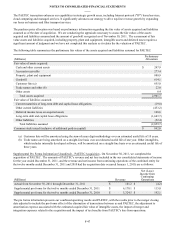Windstream 2011 Annual Report Download - page 151
Download and view the complete annual report
Please find page 151 of the 2011 Windstream annual report below. You can navigate through the pages in the report by either clicking on the pages listed below, or by using the keyword search tool below to find specific information within the annual report.
NOTES TO CONSOLIDATED FINANCIAL STATEMENTS
____
F-43
two-class method of computing earnings per share is an earnings allocation formula that determines earnings attributable to
common shares and participating securities according to dividends declared (whether paid or unpaid) and participation rights in
undistributed earnings. Earnings per common share was computed by dividing the sum of distributed earnings and
undistributed earnings allocated to common shareholders by the weighted average number of common shares outstanding for
the period. In applying the two-class method, undistributed earnings are allocated to both common shares and non-vested
restricted shares based on the pro-rata weighted average shares outstanding during the period.
In conjunction with the acquisition of PAETEC, we granted restricted stock units to former PAETEC employees to replace
outstanding, unvested PAETEC restricted stock units held by these same employees as of the acquisition date. Since these
restricted stock units contain a non-forfeitable right to receive dividends on a one-to-one per share ratio to common shares, they
are considered participating securities and will be treated similar to the non-vested restricted shares discussed above.
Beginning in the first quarter of 2011, we began issuing performance-based restricted stock units as part of our stock-based
compensation plan. These newly issued restricted stock units and previously issued performance-based restricted shares issued
contain a forfeitable right to receive dividends. Because dividends attributable to these shares are forfeited if the vesting
provisions are not met, they are considered non-participating restricted shares and are not dilutive under the two class method
until the performance conditions have been satisfied. Since the performance conditions were satisfied for a portion of these
shares as of December 31, 2011, we considered them as well as the options granted in conjunction with the acquisition of
PAETEC (Note 9) in the computation of dilutive earnings per share using the treasury stock method.
A reconciliation of net income and number of shares used in computing basic and diluted earnings per share was as follows for
the years ended December 31:
(Millions, except per share amounts)
Basic and diluted earnings per share:
Numerator:
Income from continuing operations
Income from continuing operations allocable to participating securities
Adjusted income from continuing operations attributable to
common shares
Loss from discontinued operations
Loss from discontinued operations allocable to participating securities
Adjusted loss from discontinued operations attributable to common
shares
Net income attributable to common shares
Denominator:
Basic shares outstanding
Weighted average basic shares outstanding
Weighted average participating securities
Weighted average shares outstanding for basic earnings per share
Basic and diluted earnings per share:
From continuing operations
From discontinued operations
Net income
2011
$ 172.4
(3.4)
169.0
(0.1)
—
(0.1)
$ 168.9
516.4
(3.7)
512.7
$.33
—
$.33
2010
$ 312.7
(3.0)
309.7
—
—
—
$ 309.7
471.0
(3.0)
468.0
$.66
—
$.66
2009
$ 398.5
(3.6)
394.9
—
—
—
$ 394.9
436.6
(3.7)
432.9
$.91
—
$.91
The calculation of basic earnings per share excludes income attributable to participating non-vested restricted shares from the
numerator and excludes the dilutive impact of participating non-vested restricted shares from the denominator.
Accounting Change and Revisions
Pension Benefits – Effective during the fourth quarter of 2011, we changed our method of recognizing actuarial gains and
losses for pension benefits to recognize actuarial gains and losses in our operating results in the year in which the gains and
losses occur. Historically, we have recognized actuarial gains and losses as a component of accumulated other comprehensive
income in our consolidated balance sheets on an annual basis and amortized unrecognized gains or losses that exceed 17.5
percent of the greater of the projected benefit obligation or market-related value of plan assets on a straight-line basis over five
years. Unrecognized actuarial gains and losses below the 17.5 percent corridor were amortized into operating results over the
























